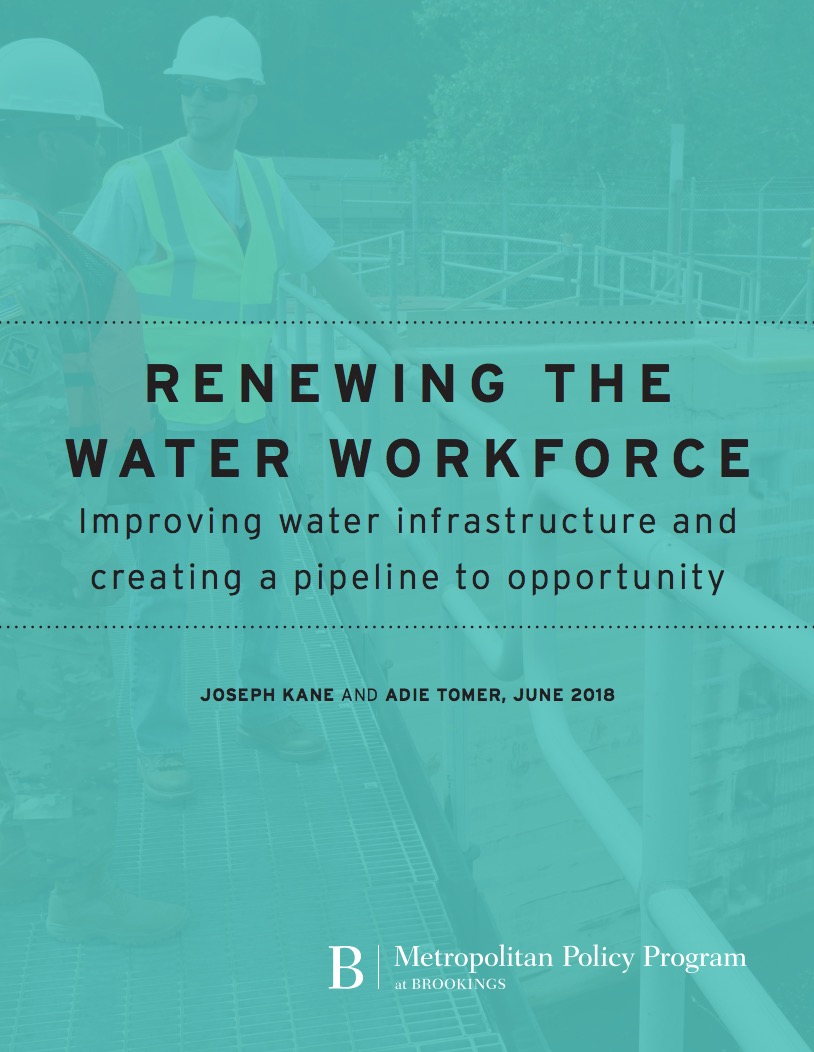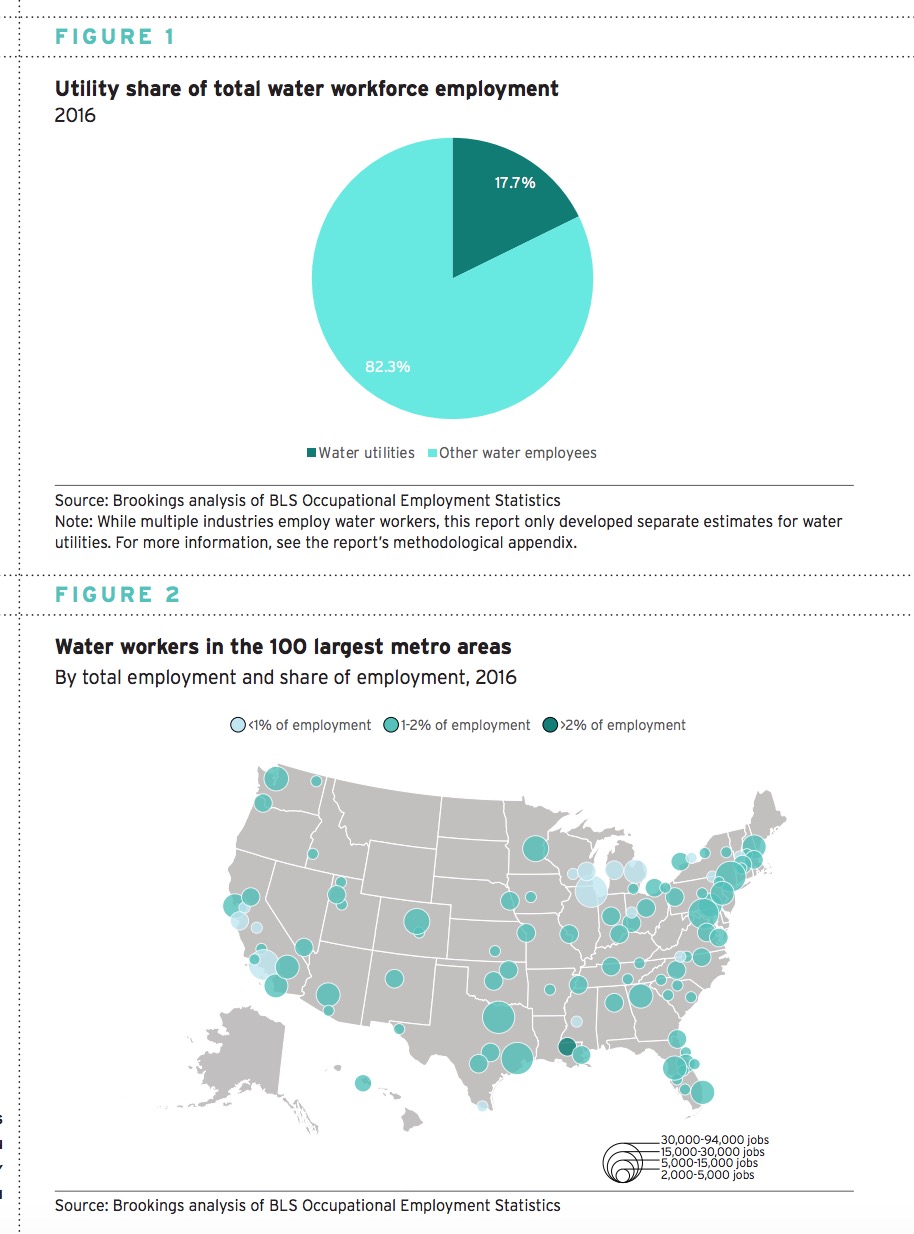METROPOLITAN POLICY PROGRAM AT BROOKINGS
By Joseph Kane and Adie Tomer
Summary
 As the U.S. economy continues to grow, many communities are struggling to translate this growth into more equitable and inclusive employment opportunities. Simultaneously, many of the nation’s water infrastructure assets are in urgent need of repair, maintenance, and restoration. Yet the workers capable of carrying out these efforts are in short supply due to an aging workforce eligible for retirement and the lack of a pipeline for new talent.
As the U.S. economy continues to grow, many communities are struggling to translate this growth into more equitable and inclusive employment opportunities. Simultaneously, many of the nation’s water infrastructure assets are in urgent need of repair, maintenance, and restoration. Yet the workers capable of carrying out these efforts are in short supply due to an aging workforce eligible for retirement and the lack of a pipeline for new talent.
However, addressing these two challenges together offers an enormous infrastructure and economic opportunity. Constructing, operating, designing, and governing water infrastructure systems demands a skilled workforce, and hiring a diverse workforce can support greater economic mobility. To unlock this opportunity, local, state, and national leaders must work together to better understand current workforce challenges and develop new techniques to hire, train, and retain water workers.
By analyzing occupational employment data, this report explores the water workforce in greater depth to uncover the accessible, well-paying opportunities in this sector. In particular, it finds:
A. In 2016, nearly 1.7 million workers were directly involved in designing, constructing, operating, and governing U.S. water infrastructure, spanning a variety of industries and regions. Water utilities employ many workers, but multiple other industries and establishments, including engineering firms and construction contractors, are essential to the water sector too. Collectively, the water workforce fills 212 different occupations—from positions in the skilled trades like electricians and technicians to financial, administrative, and management positions—that are found everywhere, from big metropolitan markets to smaller rural areas.
B. Water occupations not only tend to pay more on average compared to all occupations nationally, but also pay up to 50 percent more to workers at lower ends of the income scale. Water workers earn hourly wages of $14.01 and $17.67 at the 10th and 25th percentiles, respectively, compared to the hourly wages of $9.27 and $11.60 earned by all workers at these percentiles across the country. Significantly, workers across 180 of the 212 water occupations—or more than 1.5 million workers— earn higher wages at both of these percentiles, including many in positions that tend to require lower levels of educational attainment.
C. Most water workers have less formal education, including 53 percent having a high school diploma or less. Instead, they require more extensive on-the-job training and familiarity with a variety of tools and technologies. While 32.5 percent of workers across all occupations nationally have a high school diploma or less, a majority of water workers fall into this category, speaking to the lower formal educational barriers to entry into these types of positions. However, 78.2 percent of water workers need at least one year of related work experience, and 16 percent need four years or more, highlighting the need for applied learning opportunities.
D. Water workers tend to be older and lack gender and racial diversity in certain occupations; in 2016, nearly 85 percent of them were male and two-thirds were white, pointing to a need for younger, more diverse talent. Some water occupations are significantly older than the national median (42.2 years old), including water treatment operators (46.4 years old). Meanwhile, women make up only a fraction of employment in some of the largest water occupations overall, including plumbers (1.4 percent). Finally, there is a particularly low share of black and Asian workers employed in the water sector; together, they only make up 11.5 percent of the water workforce, compared to 18 percent of those employed in all occupations nationally.
Based on these findings and dozens of conversations with utility leaders and other workforce groups, the report lays out a new water workforce playbook for public, private, and civic partners to use in future hiring, training, and retention efforts. Utilities and other employers need to adjust existing hiring procedures and pilot new training efforts in support of the water workforce; communities need to hold more consistent dialogues and develop more collaborative platforms; and national and state leaders need to provide clearer technical guidance and more robust programmatic support.
Ultimately, the report reveals the sizable economic opportunity offered by water jobs, including the variety of occupations found across the country, the equitable wages paid, the lower educational barriers to entry, and the need for more diverse, young talent.
Introduction
Nearly a decade since the end of the Great Recession, shared prosperity remains a challenge in many communities across the United States. High-income households are now earning up to 14 times as much as low-income households in some markets.1 Racial disparities in employment are also widespread; from 2015 to 2016, employment rates for whites increased in 72 of the country’s 100 largest metro areas, but they increased in only 41 of these metro areas for both whites and people of color.
Individual neighborhoods are also experiencing deeply entrenched levels of poverty, as their residents remain disconnected from opportunity. Meanwhile, smaller metro areas and rural localities account for a dwindling share of national output and a declining share of jobs.
Nevertheless, many communities are also beginning to develop new strategies to promote more inclusive economic development and increase their economic competitiveness. Despite continued uncertainty at the national level, local leaders are investing in technological innovation, affordable housing, and workforce development to help their residents overcome barriers to better pay and shared prosperity, particularly for women and people of color. In support of an increasingly diverse population, these strategies are helping all types of individuals respond and adapt to the economic disruptions of today’s digital age, where an ever-changing set of skills and training are needed to drive production.
Investing in infrastructure represents one of the timeliest ways for the country to support long-lasting pathways to economic opportunity for all Americans. Infrastructure-related occupations tend to provide competitive wages, while not requiring as much formal education. And the country’s water infrastructure, in particular, is well positioned to offer more durable careers to a wide variety of workers across urban and rural areas alike.
The economic opportunity stems from the urgent investment needs around the country’s water infrastructure assets. Municipalities, led by water utilities, are often at the front line of this challenge, responsible for more than 95 percent of public spending on operations and capital improvements annually. With $655 billion in capital investments needed nationally over the next 20 years, utilities are working alongside a host of different partners to address physical infrastructure needs head-on. Together, for instance, 30 of the country’s largest water utilities are estimated to spend $23 billion annually on operations and capital projects, while contributing $524 billion to the economy over the next decade.
Renewing America’s water infrastructure will require a skilled workforce to construct, operate, and maintain facilities for decades to come. However, meeting these demands depends on more coordinated, purposeful actions by water utilities, other employers, workforce development partners, and state and national leaders. These actions also need to acknowledge how utilities are often positioned as anchor institutions in many regions, with nearly 52,000 water systems spread across the country. There is a genuine opportunity to promote shared prosperity in the communities that utilities and other water sector actors serve, but seizing this opportunity requires a clearer recognition of the economic importance of the water workforce and a better articulation of future actions.
This report aims to identify the extent of the U.S workforce involved in overseeing water infrastructure. Through a combination of quantitative and qualitative information— including dozens of conversations with utility leaders and other workforce groups across the country—the report finds that the water workforce represents a crucial segment of the labor market.
To start, the report first examines some of the major hurdles that face water workers and employers looking to fill positions. It then explores the economic opportunity offered by water jobs, including the variety of occupations found across the country, the equitable wages paid, the lower educational barriers to entry, and the need for more diverse, young talent. The report outlines some of the major implications emerging from this analysis, before finally laying out a set of actionable strategies—a new water workforce playbook—that local, state, and national leaders should use in future hiring, training, and retention efforts.
What is Water Infrastructure?
Water infrastructure spans several different man-made and natural systems that supply, treat, and conserve water. These systems range from traditional gray infrastructure, such as pipes, pumps, and centralized treatment plants, to green infrastructure, such as rain gardens and other related natural assets that tend to be more decentralized. They also include individual on-site treatment systems, such as septic systems, and other related physical assets specific to individual buildings, such as plumbing. In addition, rivers, lakes, ponds, wetlands, and subsurface aquifers are critical components of water infrastructure, as well as large man-made structures, such as aqueducts and levees. When this report refers to “water infrastructure,” it is referring to the entirety of the country’s drinking water, wastewater, stormwater, and green infrastructure systems.
The water workforce carries out work activities that ultimately support this extensive network, which is vital to providing and protecting clean, safe, and reliable water each day. The report’s methods section describes these definitions in greater depth.
Download full version (PDF): Renewing the Water Workforce
About the Metropolitan Policy Program at Brookings
www.brookings.edu/program/metropolitan-policy-program
The Metropolitan Policy Program at Brookings delivers research and solutions to help metropolitan leaders build an advanced economy that works for all
Tags: Brookings Institution, Brookings Metropolitan Policy Program, Metropolitan Policy Program, Water







 RSS Feed
RSS Feed